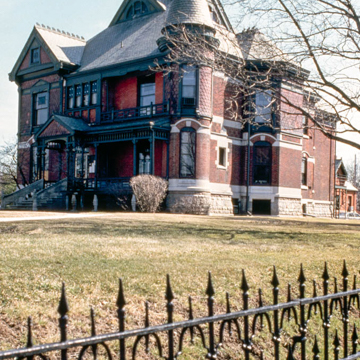You are here
Niles City Hall (Henry Austin Chapin House)
The Henry Austin Chapin House, now the city hall, is an extraordinary example of the picturesque possibilities of the Queen Anne style. Chapin (1813–1898), a general store operator in Niles, invested in 1865 in Upper Peninsula mineral lands on which an immense deposit of iron ore was discovered in 1878. The Chapin Mine at Iron Mountain paid royalties that Chapin used in constructing this house and in acquiring other real estate in Niles and Chicago. Otis Leonard Wheelock and William Wilson Clay, specialists in residential work in Chicago, created this one-of-a-kind house in Michigan.
The pressed-red-brick house stands on a foundation of Bedford bluestone, finished with a granite water table. A turreted, round corner tower and a profusion of gables, bays, and projecting and receding porches all but conceal the house's two-and-a-half-story, hipped-roof mass. Panels of herringbone, checkerwork, and lozenge-pattern brickwork as well as lathe-turned and chamfer-edged posts and beams, metal crestings, sunbursts, and rosette insets lavishly decorate the exterior. Inside, a central hall runs along the main axis of the building, from which opened the parlor, the library, the sitting room, and the dining room on the first floor, and the bedrooms on the second. Rooms are finished in fine oak, cherry, walnut, and bird's-eye maple and installed with stained glass and fancy fireplaces.
The former carriage house serves as the Fort St. Joseph Museum.
Writing Credits
If SAH Archipedia has been useful to you, please consider supporting it.
SAH Archipedia tells the story of the United States through its buildings, landscapes, and cities. This freely available resource empowers the public with authoritative knowledge that deepens their understanding and appreciation of the built environment. But the Society of Architectural Historians, which created SAH Archipedia with University of Virginia Press, needs your support to maintain the high-caliber research, writing, photography, cartography, editing, design, and programming that make SAH Archipedia a trusted online resource available to all who value the history of place, heritage tourism, and learning.







